‘Who’ did we pay with? – the Forint throughout history
Although Hungary has been part of the European Union since 2004, we still have not entered the eurozone. So, our unique currency is still in use and we pay with coins and banknotes of the Hungarian Forint every day. How much do we know about the Forint, though?
The Forint was introduced on 1st August 1946, shortly after the end of the Second World War. This became necessary after the severe inflation that took place in the past years – there was a banknote for 100 million Pengő, the banknote with the highest denomination ever in the world, and it was worth practically nothing as soon as it came out, due to the hyperinflation.
The Forint had been in use for certain periods of time throughout the history of Hungary. Between 1325 and 1553, Hungarians used the Golden Forint. Forint became the official currency again between 1750 and 1892.
When it was introduced for the third time, in 1946, it was accompanied by the ‘Fillér’, 100 of which was worth 1 Forint and it had gold behind it as collateral.
By now, the Forint has joined the system of the floating exchange rates and the Fillér has been withdrawn from circulation by 1999.
In 1946, at the beginning of the current Forint’s history, there were coins of 1, 2 and 5 Forints and coins of 2, 10 and 20 Fillérs. When the regime change came in 1989, coins of up to 200 Forints were introduced, although the 1 and 2-Forint coins were withdrawn in 2008, so now the smallest denomination is the 5-Forint coin. The 200-Forint banknote was also withdrawn and got replaced by coins in 2009.
The design of the banknotes
Hungary’s banknotes were unique in the sense that, unlike in many other socialist countries, there were no portraits of the leaders of the labour movement or any depictions of a socialist state’s symbols. One side of the notes displayed a significant figure of Hungarian art and history – for educational purposes – while the other side was taken up by a piece of art.
The style of the notes was strictly in line with academism and thus was praised abroad as well.
1947-48 banknotes
10-Forint note
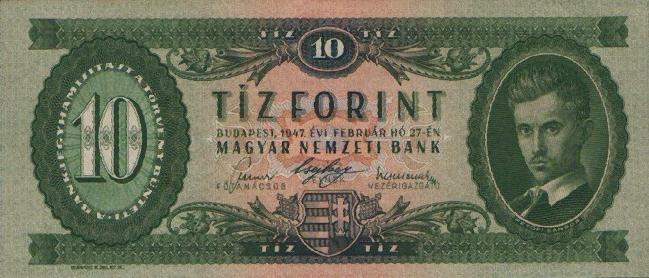
Photo: commons.wikimedia.org
One side of the note featured Sándor Petőfi, one of the most famous Hungarian poets, who was a strong supporter – and, in fact, a participant – of the 1848-49 uprising. He lost his life on the battlefield, although his body was never found, creating an aura of mystery around the poet.
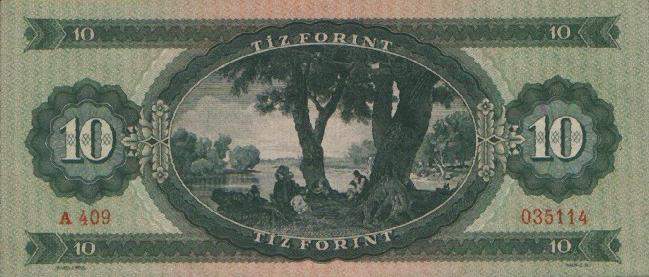
Photo: commons.wikimedia.org
On the flip side of the note, an artwork entitled View from the shore was featured, by János Jankó. A lot of his artwork depicted idyllic scenes from the lives of peasants.
20-Forint note

Photo: commons.wikimedia.org
On one side of the 20-Forint banknote, György Dózsa was featured. He was the leader of the peasant uprising of 1514 that led to a crusade. He was brutally executed but became an important symbol for Hungarians – evidenced by the fact that he was featured on the Hungarian currency for a number of years. Not to mention the many schools, streets, squares and even sports clubs that bear his name, even today.
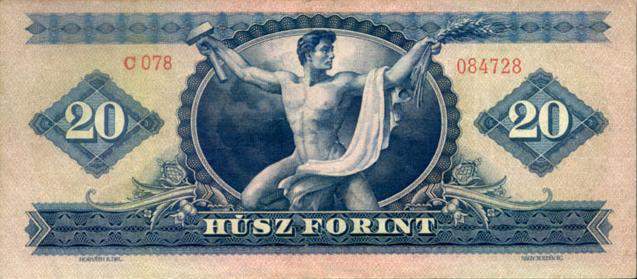
Photo: commons.wikimedia.org
The other side of this note could be a bit shocking – it is a nude portrait of István Hegedűs, a Hungarian pentathlete. There is also a funny riddle associated to this banknote, playing on Hegedűs’s nudity as well as the contrast between his young portrait and Dózsa’s old-age picture.
100-Forint banknote

Photo: commons.wikimedia.org
This banknote displays Lajos Kossuth on one side, an important figure of the 19th century. He was the minister of finance in the Batthyány-cabinet in 1848 and was an intellectual leader of the 1848-49 uprising, after which he lived in exile and died outside the country, too.
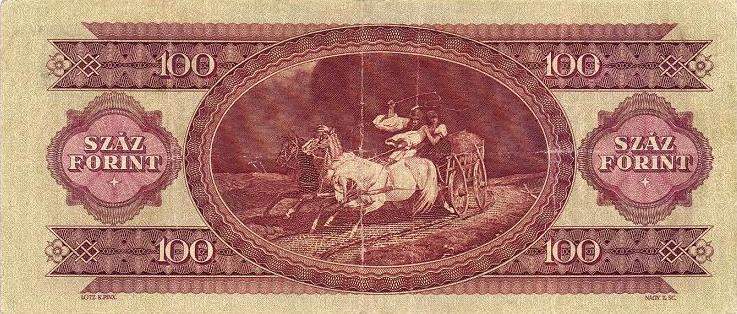
Photo: commons.wikimedia.org
The flip side features a painting by Károly Lotz, with the title Escape from the Coming Storm. He was famous for his portraits and followed the style of academism as well.
All of the above notes featured the Kossuth coat of arms.
1949-51 banknotes
Some changes were made to the 1947-48 version of the notes. The Kossuth coat of arms was replaced by the Rákosi coat of arms and, while the artwork of the existing notes did not change, there was a new addition: the 50-Forint note.
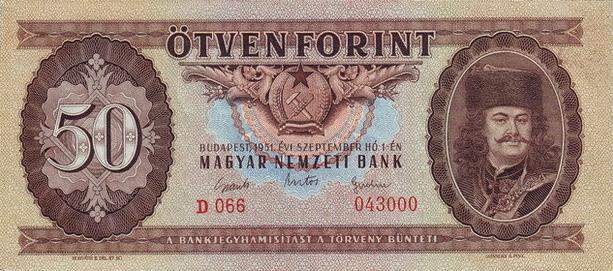
Photo: commons.wikimedia.org
This note was unique in the sense that it featured Ferenc Rákóczi the Second, leader of the uprising against the Habsburgs (that is actually named after him), who was a nobleman and became the prince of Transylvania between 1704 and 1711. He was also forced into exile after the uprising was defeated, and died in Turkey. He never stopped caring about the fate of Hungary, though, and is nowadays considered a national hero.
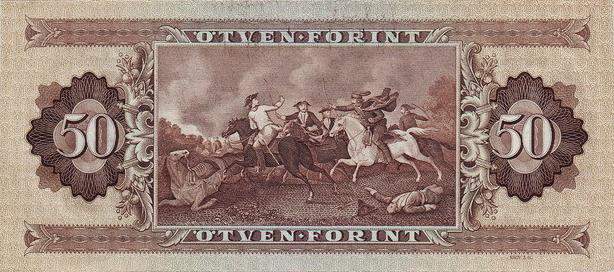
Photo: commons.wikimedia.org
The flip side of the note features a battle scene from the uprising led by Rákóczi.
1957-83 banknotes
Between 1957 and 1983, there was another change of the coat of arms – Rákosi’s was replaced by Kádár’s. Moreover, two additional notes were introduced.
500-Forint note
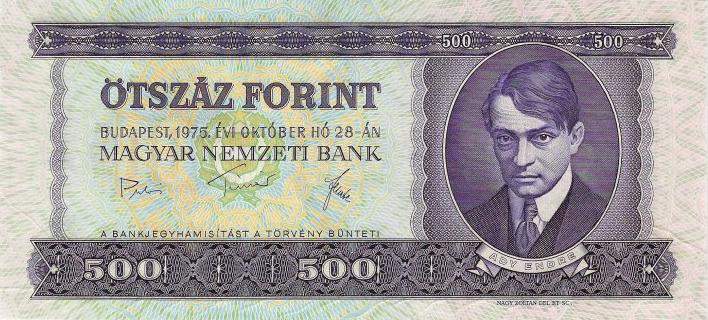
Photo: commons.wikimedia.org
One side of the note displays the view of Budapest from the Elisabeth Bridge while the other depicts Endre Ady, a famous 20th-century poet. Ady was invested in political journalism and wrote poems about all aspects of life, from love and faith to patriotism, freedom, equality and death as well.

Photo: commons.wikimedia.org
1000-Forint note
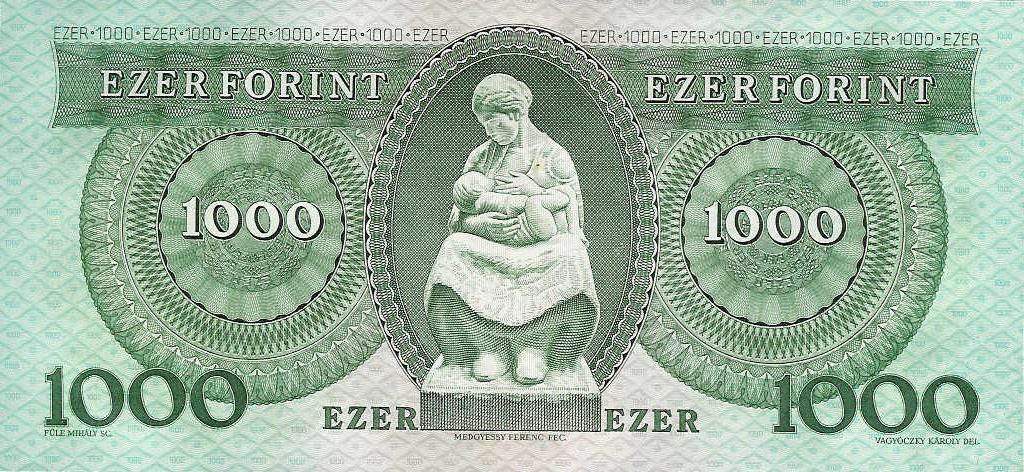
Photo: commons.wikimedia.org
One side of the 1000-Forint note displayed a portrait of a mother with a child by Ferenc Medgyessy, while the other side used to feature Béla Bartók, a composer and ethnomusicologist. He is one of the most important composers of the 20th century, while his ethnomusicological work is important not only for Hungary but for all of Central Europe and, in fact, for universal culture as well. He was posthumously awarded the International Peace Award.
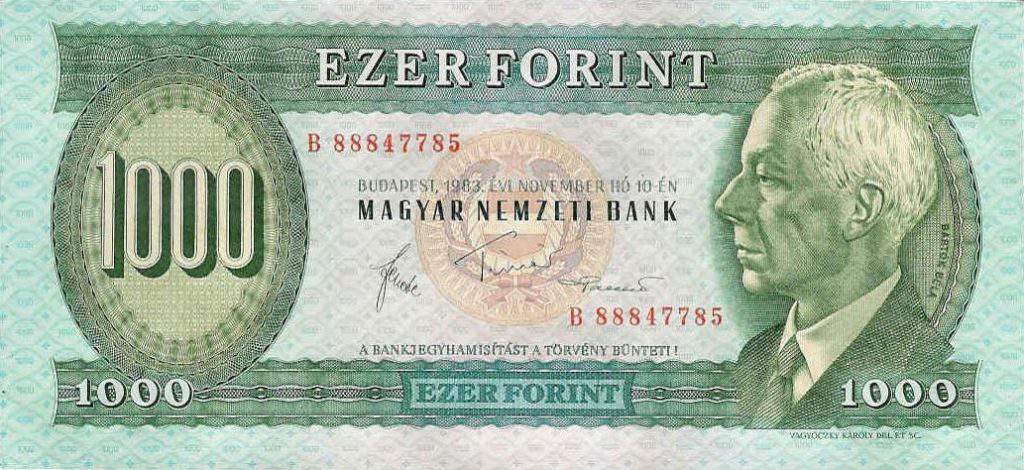
Photo: commons.wikimedia.org
1990-1992 banknotes
There was one last change to the previous banknotes before the currently-used-ones were introduced. The Kádár coat of arms was replaced by the current coat of arms, featuring the crown and the Hungarian tricolour. There was another banknote introduced as well: the 5000-Forint note.
5000-Forint note
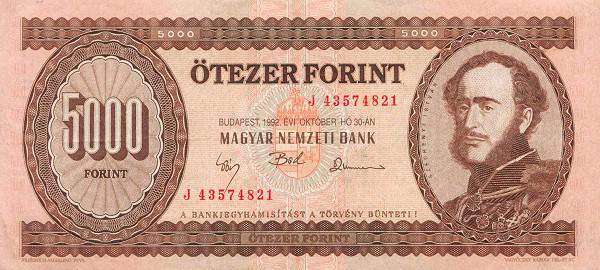
Photo: commons.wikimedia.org
This note features István Széchenyi, a crucial figure of the 19th century and the Reform Era. He is often referred to as the ‘greatest Hungarian’. A contemporary of Kossuth, he affected several areas of improvement in the capital. The construction of the Chain Bridge is connected to his name, as well as the founding of the Hungarian Academy of Sciences.
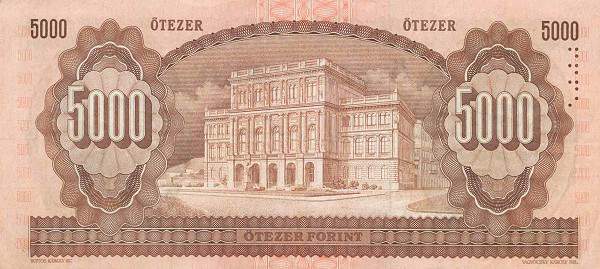
Photo: commons.wikimedia.org
That is presumably why the building of the Academy is featured on the reverse side.
Several changes took place since then, for instance, there is no longer a 10-Forint banknote (or a 20- and 100-Forint one, for that matter), and the portraits changed a bit, too. However, it is interesting to look back in time and compare who made it onto the notes back then versus who is on them now.
For more news, check out this article about the best Hungarian baths of 2018.
Source: ecopedia.hu, hu.wikipedia.org





